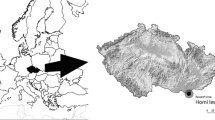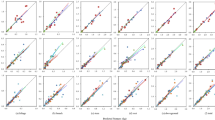Abstract
Three different experiments in birch (Betula pubescens Ehrh. andBetula pendula Roth) stands were conducted during summer 1991: an evaluation of the accuracy of the vertical tube method measuring crown free projection (CFP) in four birch stands; a study of relative irradiance (RI; photosynthetically active radiation, PAR), in birch stands differing in stem density and basal area; and an estimation of the CFP in different types of birch stands and the correlation between RI and CFP. The results indicate that the number of observation points well distributed over an area of 0.1 ha can vary between 50 and 200 to achieve sufficient accuracy. There were no significant differences in the CFP estimates made on the same plot by different observers including an untrained observer. CFP was related to basal area, stem number and diameter sum in a non-linear regression, CFP = A*e-BX. The correlations between RI and basal area, density and diameter sum, respectively, were 0.54, 0.57 and 0.67 for PAR. The coefficients of determination for RI (PAR) and CFP were high (0.86).
Similar content being viewed by others
References
Anderson MC (1966a). Some problems of single characterization of the light climate in plant communities. In: Bainbridge R, Evans GC, Rackham O (eds) Light as an ecological factor. Brit Ecol Soc Symp 6: 77–90
Andersson MC (1966b) Stand structure and light penetration. II. A theoretical analysis. J Appl Ecol 3: 41–54
Anderson MC (1970) Interpreting the fraction of solar radiation available in forest. Agric Meteorol 7: 19–28
Baldochi DD, Matt DR, Hutchinson NA, McMillen RT (1984) Solar radiation within an oak-hickory forest: an evaluation of the extinction coefficients for several radiation components during fully-leafed and leafless periods. Agric For Meterol 32: 307–322
Baldocchi DD, Hutchinson B, Matt D, McMillen R (1985) The effect of clumped foliage on the radiation regime in a deciduous forest canopy. In: Proc. 17th Conf. Agricultural and Forest Meteorology and 7th Conf. Biometeorology and Aerobiology, Scottsdale, Ariz. American Meterological Society, Boston, pp 237–238
Borman F (1956) Percentage light readings, their intensity-duration aspects, and their significance in the estimation of photosynthesis. Ecology 37: 473–476
Buell MF, Gordon WE (1945) Hardwood-conifer forest contact zone in Itasca Park Minesota. Am Midl Nat 34: 433–439
Chambers JL, Jenkins MW (1983) Understorey light intensity in bottomland hardwood stands. USDA For Serv Gen Tech Rep SE-24, 161–165
Eckersten H (1984) Light penetration and photosynthesis in a willow stand. In: Perttu K (ed) Ecology and management of forest biomass production systems. Swed Univ Agric Sci Dept Ecol and Environm Res Rep 15: 29–45
Federer CA (1971) Solar radiation absorption by leafless hardwood forests. Agric Meteorol 9: 3–20
Gay LW, Knoerr KR, Braaten MO (1971) Solar radiation variability on the floor of a pine plantation. AgricMeteorol 8: 39–50
Garrison GA (1949) Uses and modification for the “Moosehorn” crown closure estimator. J For 47: 733–735
Godman RM, Kreftig LW (1960) Factors important to yellow birch establishment in upper Michigan. Ecology 41: 18–28
Håbjörg A (1972) Effects of light quality, light intensity and night temperature on growth and development of three latitudinal populations ofBetula pubescens Ehrh. Sci. Rep Agric Univ Norway 51: 1–17
Hutchison BA, Matt DR (1977) The distribution of solar radiation within a deciduous forest. Ecol Monogr 47: 185–207
Idso SB, de Wit CT (1970) Light relations in plant canopies. Appl Opt 9: 177–184
Jackson MT, Petty KL (1981) A simple optical device for measuring vertical projection of tree crowns. For Sci 19: 60–62
Jarvis PG (1964) The adaptability to light intensity of seedlings ofQuercus petraea (Matt.) Liebl. J Ecol 52: 545–571
Jarvis PG, Leverenz JW (1983) Productivity of temperate, deciduous and evergreen forests. In: Lange OL (ed) Encyclopedia of plant physiology (vol 12D). Physiological plant ecology. Springer, Berlin Heidelberg New York, pp 249–250
Johansson T (1985) Estimating canopy density by the vertical tube method. For Ecol Manage 11: 139–144
Johansson T (1986) Development of suckers by 2-year-old birch (Betulapendula Roth) at different temperatures and light intensities. Scand J For Res 1: 17–26
Johansson T (1987a) Irradiance in thinned Norway spruce (Picea abies) stands and the possibilities to prevent suckers of broadleaved trees. For Ecol Manage 20: 307–317
Johansson T (1987b) The importance of thinning grade in stands of Norway spruce [Piceaabies (L.) Karst.] and Scots pine (Pinussylvestris L.) to minimize suckers of birch. Swed Univ Agric Sci Dept For Yield Res Report 19
Johansson T (1987c) Development of stump suckers byBetula pubescens at different light intensities. Scand J For Res 2: 72–83
Johansson T (1989) Irradiance within canopies of young trees of European aspen (Populus tremula L.) and European birch (Betulapubescens Ehrh.) in stands of different spacings. For Ecol Manage 28: 217–236
Lemmon PE (1956) A spherical densitometer for estimating forest overstory density. For Sci 2: 314–320
Lemeur R, Rosenberg NJ (1979) Simulating the quality and quantity of shortwave radiation within and above canopies. In: S. Halldin (ed) Comparison of forest water and energy exchange models. Int Soc Ecol Modelling. Copenhagen, pp 77–100
Lindroth A, Perttu KL (1981) Simple calculation of extinction coefficient of forest stands. Agric For Meterol 25: 97–110
Logan KT (19659) Growth of tree seedlings as affected by light intensity. I. White birch, yellow birch, sugar maple and silver maple. Canada Dept For Publ No 1121
MacLellan AJ, Frankland B (1985) A simple field method for measuring light quality. Seasonal changes in a temperate deciduous wood. Photobiology 42: 689–695
Maruyama Y, Morikawa Y, Inoue T (1984) Effect of light quality, shading and intermittent light on the growth of birch seedlings. J Jpn For Soc 66: 361–367
Maruyama Y, Inoue I, Morikawa Y (1986) Light-photosynthesis curves of leaves on birch seedlings grown under different light conditions. J Jpn For Soc 68: 10–14
Miller PC (1969) Tests of solar radiation models in three forest canopies. Ecology 50: 879–885
Miller EE, Norman JM (1971) A sunfleck theory for plants canopies. II. Penumbra effect: intensity distributions along sunfleck segments. Agron J 63: 739–743
Minckler LS (1961) Measuring light in uneven aged hardwood stands. Cent States For Exp Stn Tech Pap 184
Monsi M, Saeki T (1953) Uber den Lichtfaktor in den Pflanzengesellschaften und seine Bedeutung für die Stoffproduktion. Jpn J Bot 14: 22–52
Montana C, Ezcurra E (1980) Simple instrument for quick measurement of crown projections. J For 78: 699
Nash RW, Duda EJ (1951) Studies on extensive dying, regeneration and management of birch. Maine For Serv Bull No 15
Norman JM, Miller EE, Tanner CB (1971) Light intensity and sunfleck-size distributions in plant canopies. Agron J 63: 743–748
Nygren M, Kellomäki S (1983) Effect of shading on leaf structure and photosynthesis in young birches,Betula pendula Roth andBetula pubescens Ehrh. For Ecol Manage 7: 119–132
Ovington JD, Madgwick HAI (1959) A comparison of light in different woodlands. Forestry 28: 141–146
Perttu KL (1982) Radiation climate of northern forest stands. Dept For Soils Swed Univ Agric Sci Rep 38
Reifsnyder WE, Furnival GM, Horowitz JL (1971) Spatial and temporal distribution of solar radiation beneath forest canopies. Agric Meteorol 9: 21–37
Saeki T (1960) Interrelationships between leaf amount, light distribution and total photosynthesis in a plant community. Bot Mag 73: 1762–1767
Sarvas R (1953) Measurement of the crown closure of a stand. Commun Inst For Fenn 41: 1–13
Satterlund DR (1983) Forest shadows: how much shelter in a shelterwood? For Ecol Manage 5: 27–37
Schomaker CE (1968) Solar radiation measurements under a spruce and a birch canopy during May and June. For Sci 14: 31–38
Shirley HL (1932) Light intensity in relation to plant growth in a virgin Norway pine forest. J Agric Res 44: 228–244
Vezina PE, Péch G (1964) Solar radiation beneath canopies in relation to crown closure. For Sci 10: 443–451
Wilson JW (1965) Stand structure and light penetration. I. Analysis by point quadrats. J Appl Ecology 2: 383–390
Zar JH (1974) Biostatistical analysis. Prentice-Hall, London
Author information
Authors and Affiliations
Rights and permissions
About this article
Cite this article
Johansson, T. Estimation of canopy density and irradiance in 20- to 40-year-old birch stands (Betula pubescens Ehrh. andBetula pendula Roth). Trees 10, 223–230 (1996). https://doi.org/10.1007/BF02185673
Received:
Accepted:
Issue Date:
DOI: https://doi.org/10.1007/BF02185673




